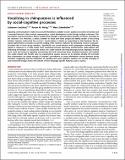Files in this item
Vocalizing in chimpanzees is influenced by social-cognitive processes
Item metadata
| dc.contributor.author | Crockford, Catherine | |
| dc.contributor.author | Wittig, Roman M. | |
| dc.contributor.author | Zuberbuehler, Klaus | |
| dc.date.accessioned | 2018-01-05T15:30:15Z | |
| dc.date.available | 2018-01-05T15:30:15Z | |
| dc.date.issued | 2017-11-15 | |
| dc.identifier | 251882082 | |
| dc.identifier | 3c6404a4-18fc-45cc-9fc8-b1641a8f4b8d | |
| dc.identifier | 000418002000037 | |
| dc.identifier | 85041919191 | |
| dc.identifier | 000418002000037 | |
| dc.identifier.citation | Crockford , C , Wittig , R M & Zuberbuehler , K 2017 , ' Vocalizing in chimpanzees is influenced by social-cognitive processes ' , Science Advances , vol. 3 , no. 11 , e1701742 . https://doi.org/10.1126/sciadv.1701742 | en |
| dc.identifier.issn | 2375-2548 | |
| dc.identifier.other | ORCID: /0000-0001-8378-088X/work/64360723 | |
| dc.identifier.uri | https://hdl.handle.net/10023/12439 | |
| dc.description | The study was funded by the Leverhulme Trust, the British Academy, the Max Planck Society, the Leakey Foundation, and the European Research Council under the European Union’s Horizon 2020 research and innovation programme (grant agreement nos. 679787 and 283871) | en |
| dc.description.abstract | Adjusting communication to take into account information available to one's audience is routine in humans but is assumed absent in other animals, representing a recent development on the lineage leading to humans. This assumption may be premature. Recent studies show changes in primate alarm signaling to threats according to the receivers' risk. However, a classic problem in these and other perspective-taking studies is discerning whether signalers understand the receivers' mental states or simply are responding to their behavior. We designed experiments to exclude concurrent reading of the receivers' behavior by simulating receivers using prerecorded calls of other group members. Specifically, we tested whether wild chimpanzees emitted differing signals in response to a snake model when simulated receivers previously emitted either snake-related calls (indicating knowledge) or acoustically similar non-snake-related calls (indicating ignorance). Signalers showed more vocal and nonvocal signaling and receiver-directed monitoring when simulated receivers had emitted non-snake-related calls. Results were not explained by signaler arousal nor by receiver identity. We conclude that chimpanzees are aware enough of another's perspective to target information toward ignorant group members, suggesting that the integration of signaling and social cognition systems was already emerging in early hominoid lineages before the advent of more language-specific features, such as syntax. | |
| dc.format.extent | 12 | |
| dc.format.extent | 1049594 | |
| dc.language.iso | eng | |
| dc.relation.ispartof | Science Advances | en |
| dc.subject | BF Psychology | en |
| dc.subject | DAS | en |
| dc.subject.lcc | BF | en |
| dc.title | Vocalizing in chimpanzees is influenced by social-cognitive processes | en |
| dc.type | Journal article | en |
| dc.contributor.institution | University of St Andrews. School of Psychology and Neuroscience | en |
| dc.contributor.institution | University of St Andrews. Institute of Behavioural and Neural Sciences | en |
| dc.contributor.institution | University of St Andrews. Centre for Social Learning & Cognitive Evolution | en |
| dc.identifier.doi | 10.1126/sciadv.1701742 | |
| dc.description.status | Peer reviewed | en |
This item appears in the following Collection(s)
Items in the St Andrews Research Repository are protected by copyright, with all rights reserved, unless otherwise indicated.

